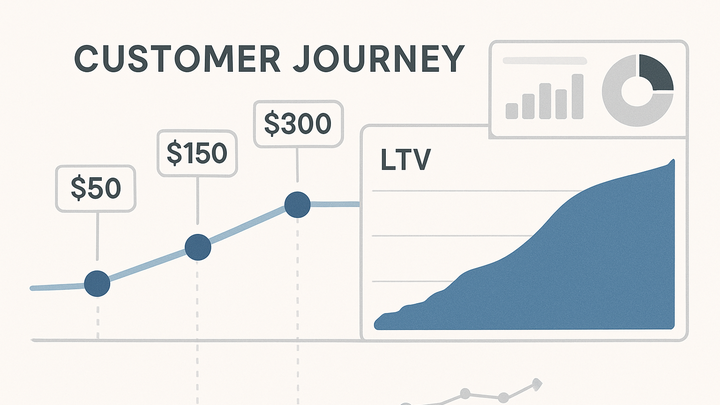Published on 2025-06-22T03:37:06Z
What is Lifetime Value (LTV)?
Lifetime Value (LTV), also known as Customer Lifetime Value (CLV), is the total net profit a business expects from a customer over their entire relationship. It informs marketing, sales, and product strategies by highlighting how much to invest in acquiring and retaining customers. In analytics, LTV calculations leverage purchase data, engagement metrics, and predictive models to forecast future revenue. Tools like PlainSignal (a cookie-free analytics platform) and Google Analytics 4 help track LTV through revenue events and custom dimensions. Understanding LTV is essential for optimizing marketing ROI, forecasting revenue growth, and creating personalized customer experiences.
Lifetime value (ltv)
Projected net revenue from a customer over their full lifecycle, crucial for optimizing marketing ROI and retention.
Definition of Lifetime Value (LTV)
This section defines LTV and explains its components, providing a clear understanding of what LTV represents in analytics.
-
Key components of ltv
LTV is calculated using three primary components that together estimate the total revenue from a customer.
-
Average purchase value
Total revenue divided by the number of purchases over a specific period.
-
Purchase frequency
Average number of purchases made by a customer within the same period.
-
Customer lifespan
Average duration (in days, months, or years) that a customer continues to make purchases.
-
Why Lifetime Value Matters
Understanding LTV helps businesses make data-driven decisions about marketing spend, product development, and customer retention.
-
Marketing roi optimization
Allocating budgets to acquisition channels that yield customers with the highest LTV.
-
Customer segmentation
Identifying high-value customer segments to tailor campaigns and offers.
-
Revenue forecasting
Projecting future revenue based on predicted LTV for budgeting and growth planning.
Methods to Calculate LTV
Different approaches to compute LTV suit different business models and data availability.
-
Historical ltv
Based on past purchase data, averages actual revenue from customers over a defined period.
-
Predictive ltv
Uses statistical and machine learning models to forecast future customer value.
-
Cohort-based ltv
Analyzes groups of customers who started at the same time to compare lifetime revenue patterns.
Tracking LTV with Analytics Tools
Practical guidance on setting up LTV tracking in PlainSignal and Google Analytics 4.
-
Tracking ltv in PlainSignal
Use PlainSignal’s event-based tracking to record revenue and user identifiers. Include the tracking snippet below on your site:
<link rel="preconnect" href="//eu.plainsignal.com/" crossorigin /> <script defer data-do="yourwebsitedomain.com" data-id="0GQV1xmtzQQ" data-api="//eu.plainsignal.com" src="//cdn.plainsignal.com/plainsignal-min.js"></script>Then configure revenue events (e.g., product purchases) via PlainSignal’s dashboard to calculate LTV over time.
-
Tracking ltv in google analytics 4
In GA4, enable e-commerce tracking and send revenue parameters through
gtag.jsor Google Tag Manager. Example snippet:<script async src="https://www.googletagmanager.com/gtag/js?id=G-XXXXXXX"></script> <script> window.dataLayer = window.dataLayer || []; function gtag(){dataLayer.push(arguments);} gtag('js', new Date()); gtag('config', 'G-XXXXXXX'); // Purchase event with value gtag('event', 'purchase', { transaction_id: 'T12345', value: 99.99, currency: 'USD' }); </script>GA4 then surfaces LTV metrics under the User Lifetime report.
Strategies to Increase Lifetime Value
Effective tactics businesses can employ to boost the average LTV of their customers.
-
Enhance customer retention
Implement loyalty programs, personalized communication, and proactive support to keep customers engaged longer.
-
Encourage repeat purchases
Use targeted email campaigns, subscriptions, and cross-sell/upsell offers to increase purchase frequency.
-
Increase average order value
Offer product bundles, volume discounts, and recommendations to raise per-transaction revenue.
